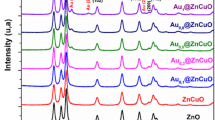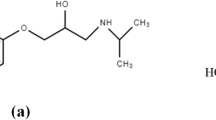Abstract
Bio-mediated Ag-doped cuprous oxide nanoparticles (Ag@Cu2O NPs) were synthesised using Tabernaemontana divaricate leaves extract, as a reducing agent for the reduction Ag+ to Ag0. Synthesised Ag@Cu2O NPs were characterised by several techniques such as UV–Vis spectroscopy, FT-IR and XRD. Doping Ag onto Cu2O nanoparticles reduced the bandgap of Cu2O to 1.8 eV from 2.1 eV and enhanced photocurrent. The crystallite size of prepared Ag@Cu2O NPs was estimated to be 48 nm using Scherrer’s equation. The photocatalytic activity of Ag@Cu2O NPs was tested against 4-aminopyridine under visible light. The synthesised photocatalysis showed 95% degradation efficiency and 98% chemical oxygen demand removal for 4-aminopyridine at optimized conditions (4-aminopyridine: 5 ppm, catalyst dosage: 0.8 g/L and temperature 30 °C) after 235 min of reaction time at pH 3.
Graphical abstract









Similar content being viewed by others
References
Chelli VR, Chakraborty S, Golder AK (2018) Ag-doping on TiO2 using plant-based glycosidic compounds for high photonic efficiency degradative oxidation under visible light. J Mol Liq 271:380–388. https://doi.org/10.1016/j.molliq.2018.08.140
Gupta A, Tandon M, Kaur A (2020) Role of metallic nanoparticles in water remediation with special emphasis on sustainable synthesis: a review. Nanotechnol Environ Eng. https://doi.org/10.1007/s41204-020-00092-y
Takenaka S, Nomura R, Minegishi A, Yoshida KI (2013) Enrichment and characterization of a bacterial culture that can degrade 4-aminopyridine. BMC Microbiol 13(1):1–10. https://doi.org/10.1186/1471-2180-13-62
Baruah M, Supong A, Bhomick PC et al (2020) Batch sorption–photodegradation of Alizarin Red S using synthesized TiO2/activated carbon nanocomposite: an experimental study and computer modelling. Nanotechnol Environ Eng 5:1–13. https://doi.org/10.1007/s41204-020-00071-3
Jassal V, Shanker U, Gahlot S (2016) Green synthesis of some iron oxide nanoparticles and their interaction with 2-amino, 3-amino and 4-aminopyridines. Mater Today Proc 3:1874–1882. https://doi.org/10.1016/j.matpr.2016.04.087
Wan X, Yang J, Huang X, Tie S, Lan S (2019) A high-performance room temperature thermocatalyst Cu2O/Ag0@Ag-NPs for dye degradation under dark condition. J Alloys Compd 785:398–409. https://doi.org/10.1016/j.jallcom.2019.01.215
Sharma K, Maiti K, Kim NH, Hui D, Lee JH (2018) Green synthesis of glucose-reduced graphene oxide supported Ag–Cu2O nanocomposites for the enhanced visible-light photocatalytic activity. Compos Part B Eng 138:35–44. https://doi.org/10.1016/j.compositesb.2017.11.021
Chakraborty S, Dutta S, Saha R, Moi SC, Sukul D, Panja SS (2017) Efficacy of a photo-catalyst towards the degradation of a pharmaceutical compound, 4-aminopyridine by application of response surface methodology. Desalin Water Treat 76:389–397. https://doi.org/10.5004/dwt.2017.20580
Pratibha GS, Ratan JK (2020) Degradation of 4-amino pyridine onto cuprous oxide nanoparticles synthesized from Tabernaemontana divaricate extract. J Indian Chem Soc 97:320–325
Yewale AG, Patil ND, Patwardhan AW (2016) Removal of pyridine from dilute aqueous streams using hollow fiber supported liquid membranes. Desalin Water Treat 57:18939–18955. https://doi.org/10.1080/19443994.2015.1093550
Venkateasan A, Prabakaran R, Sujatha V (2017) Phytoextract-mediated synthesis of zinc oxide nanoparticles using aqueous leaves extract of Ipomoea pes-caprae (L).R.br revealing its biological properties and photocatalytic activity. Nanotechnol Environ Eng 2:1–15. https://doi.org/10.1007/s41204-017-0018-7
Wang G, Gong L, Li Z, Wang B, Zhang W, Yuan B, Kuang A (2020) A two-dimensional CdO/CdS heterostructure used for visible light photocatalysis. Phys Chem Chem Phys 22:9587–9592. https://doi.org/10.1039/d0cp00876a
Li W, Zhuang C, Li Y, Gao C, Jiang W, Sun Z, Qi K (2021) Anchoring ultra-small TiO2 quantum dots onto ultra-thin and large-sized Mxene nanosheets for highly efficient photocatalytic water splitting. Ceram Int 47:21769–21776. https://doi.org/10.1016/j.ceramint.2021.04.192
Ma Y, Liu F, Liu Y, Lan X, Zhu Y, Shi J, Park SH (2021) In-situ intramolecular synthesis of tubular carbon nitride S-scheme homojunctions with exceptional in-plane exciton splitting and mechanism insight. Chem Eng J 414:128802. https://doi.org/10.1016/j.cej.2021.128802
Upadhyay S, Sharma D, Singh N, Satsangi VR, Shrivastav R, Waghmare UV, Dass S (2014) Experimental and first-principles theoretical studies on Ag-doped cuprous oxide as photocathode in photoelectrochemical splitting of water. J Mater Sci 49:868–876. https://doi.org/10.1007/s10853-013-7770-2
Ghosh P, Chelli VR, Giri AS, Golder AK (2018) Steroid glycosides as potential analytes for Cu-doping on TiO2 for photocatalytic water treatment. Environ Prog Sustain Energy 37:1973–1981. https://doi.org/10.1002/ep.12879
Falah M, Mackenzie KJD (2020) Photocatalytic nanocomposite materials based on inorganic polymers (Geopolymers): a review. Catalysts 10:1–20. https://doi.org/10.3390/catal10101158
Mohammed AM, Mohtar SS, Aziz F, Mhamad SA, Aziz M (2021) Review of various strategies to boost the photocatalytic activity of the cuprous oxide-based photocatalyst. J Environ Chem Eng 9:105138. https://doi.org/10.1016/j.jece.2021.105138
Attri P, Garg S, Ratan JK (2021) Kinetic modelling and proposed mechanistic pathway for photocatalytic degradation of 4-aminopyridine using cuprous oxide nanoparticles. Res Chem Intermed 47:1535–1562. https://doi.org/10.1007/s11164-020-04381-8
Kwon Y, Soon A, Han H, Lee H (2015) Shape effects of cuprous oxide particles on stability in water and photocatalytic water splitting. J Mater Chem A 3:156–162. https://doi.org/10.1039/c4ta04863f
Bhosale MA, Bhanage BM (2016) A simple approach for sonochemical synthesis of Cu2O nanoparticles with high catalytic properties. Adv Powder Technol 27:238–244. https://doi.org/10.1016/j.apt.2015.12.008
Tao S, Yang M, Chen H, Ren M, Chen G (2017) Microfluidic synthesis of Ag@Cu2O core-shell nanoparticles with enhanced photocatalytic activity. J Colloid Interface Sci 486:16–26. https://doi.org/10.1016/j.jcis.2016.09.051
Gosu V, Gurjar BR, Zhang TC, Surampalli RY (2016) Oxidative degradation of quinoline using nanoscale zero-valent iron supported by granular activated carbon. J Environ Eng (U S) 142:1–11. https://doi.org/10.1061/(ASCE)EE.1943-7870.0000981
Sahu K, Bisht A, Pandey A, Dutta A, Khan SA, Singhal R, Mohapatra S (2020) RF magnetron sputtered Ag–Cu2O–CuO nanocomposite thin films with highly enhanced photocatalytic and catalytic performance. Appl Surf Sci 517:146169. https://doi.org/10.1016/j.apsusc.2020.146169
Qin H, Wei Q, Wu J, Yang F, Zhou B, Wang Y, Tian S (2019) Effects of Ag nanoparticles on the visible-light-driven photocatalytic properties of Cu2O nanocubes. Mater Chem Phys 232:240–245. https://doi.org/10.1016/j.matchemphys.2019.04.081
Chelli VR, Golder AK (2018) Ag-doping on ZnO support mediated by bio-analytes rich in ascorbic acid for photocatalytic degradation of dipyrone drug. Chemosphere 208:149–158
Kumar A, Khan M, He J, Lo IMC (2020) Recent developments and challenges in practical application of visible-light-driven TiO2-based heterojunctions for PPCP degradation: a critical review. Water Res 170:115356. https://doi.org/10.1016/j.watres.2019.115356
Feng H, Wang W, Wang W, Zhang M, Wang C, Ma C, Chen S (2021) Charge transfer channels of silver @ cuprous oxide heterostructure core-shell nanoparticles strengthen high photocatalytic antibacterial activity. J Colloid Interface Sci 601:531–543. https://doi.org/10.1016/j.jcis.2021.05.113
Balamurugan B, Aruna I, Mehta BR, Shivaprasad SM (2004) Size-dependent conductivity type inversion in Cu2O nanoparticles. Phys Rev B Condens Matter Mater Phys 69:2–6. https://doi.org/10.1103/PhysRevB.69.165419
Rachna RM, Shanker U (2019) Sunlight active ZnO@FeHCF nanocomposite for the degradation of bisphenol A and nonylphenol. J Environ Chem Eng. https://doi.org/10.1016/j.jece.2019.103153
Kushwaha R, Garg S, Bajpai S (2018) Modified generalized kinetic model and degradation mechanistic pathways for catalytic oxidation of NBS dye in Fenton-like oxidation process. Res Chem Intermed 44:5759–5786. https://doi.org/10.1007/s11164-018-3453-6
Kumar A, Khan M, Zeng X, Lo IMC (2018) Development of g-C3N4/TiO2/Fe3O4@SiO2 heterojunction via sol-gel route: a magnetically recyclable direct contact Z-scheme nanophotocatalyst for enhanced photocatalytic removal of ibuprofen from real sewage effluent under visible light. Chem Eng J 353:645–656. https://doi.org/10.1016/j.cej.2018.07.153
Gnanaprakasam A, Sivakumar VM, Thirumarimurugan M (2015) Influencing parameters in the photocatalytic degradation of organic effluent via nanometal oxide catalyst: a review. Indian J Mater Sci 2015:1–16. https://doi.org/10.1155/2015/601827
Kumar J, Bansal A (2010) Photocatalytic degradation of amaranth dye in aqueous solution using sol-gel coated cotton fabric. In: Proceedings of the world congress on engineering and computer science, no 2, pp 20–22
Verma P, Kumar J (2014) Degradation and microbiological validation of Meropenem antibiotic in aqueous solution using UV, UV/H2O2, UV/TiO2 and UV/TiO2/H2O2 processes. Int J Eng Res Appl 4(7):58–65
Kumar J, Jana AK, Bansal A, Garg R (2005) Development of correlation between BOD and COD for refinery waste. Indian J Environ Prot 25(5):405
Kumar J, Bansal A (2010) Photocatalytic degradation of amaranth dye over immobilized nano-crystals of TiO2. In: International conference on energy and environment, Cambridge, pp 129–133
Acknowledgements
I acknowledge my gratitude to the head, faculty and staff members of chemical engineering department, Dr. BR Ambedkar National Institute of Technology, Jalandhar, Punjab, India-144011, for providing me with requisite research facility, for their guidance and encouragement in carrying out this research work.
Author information
Authors and Affiliations
Corresponding author
Ethics declarations
Conflict of interest
Authors have no conflict of interest.
Additional information
Publisher's Note
Springer Nature remains neutral with regard to jurisdictional claims in published maps and institutional affiliations.
Rights and permissions
About this article
Cite this article
Attri, P., Garg, S. & Ratan, J.K. Degradation of 4-aminopyridine using bio-mediated Ag-doped Cu2O nanoparticles under visible light. Nanotechnol. Environ. Eng. 7, 415–423 (2022). https://doi.org/10.1007/s41204-021-00182-5
Received:
Accepted:
Published:
Issue Date:
DOI: https://doi.org/10.1007/s41204-021-00182-5




